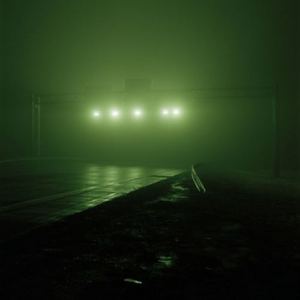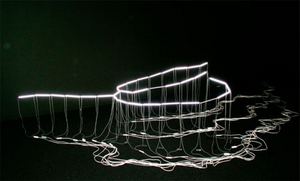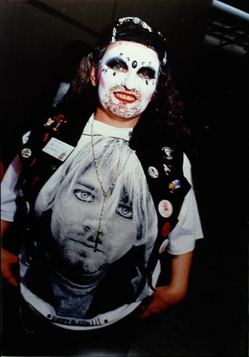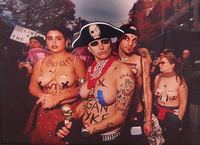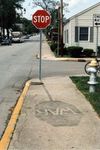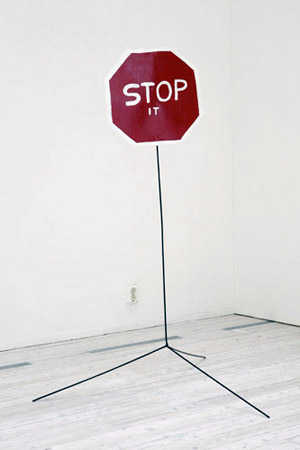Jeff Brouws, Exit 24 off of I-90, Erie, Pennsylvania, 2005
Diana DeAugustine: The penis as a wound on a woman’s thigh
Lacking Nothing (Healing Wound) is the best retort to Freud’s idea of penis envy. God bless the child who’s got her own.
DeAugustine’s piece resolves more than 20th-century problems, however.
In Plato’s Symposium, he advanced the idea of three sexes – male, female and hermaphrodite. In a bad mood, God had split them in half, which means everybody wanders the earth looking for his/her other half: both same sex and opposites attract.
In the photo on the left, DeAugstine imagines a female nailing down her other and carrying its mark on her thigh. Like Sweeney Todd with a razor in his hand, she’s compete.
Pipilotti Rist made her first big impression in 1997 with Ever is Over Again, in which a young woman strides down the street carrying a cudgel. The cudgel is a flower (men are beautiful) and a weapon (dangerous too.) As the girl in charge, she assumes both their beauty and their power.
There are other ways to have it all. Below, Alice Wheeler’s GenderFuck Courtney and Tess at WTO Anniversary.
How does this nonsense get published?
Featured today on ArtsJournal is Denver Post film critic Lisa Kennedy’s musings on the morality of the cinematic big bang – Why are movies killing our planet? I clicked on it because I thought it might be about poisonous gasses released by props, a movie set version of dumb bombs.
That story would be interesting, especially if they’d been made in China. But no. She’s upset about the morality of chaos narratives. Take it up with Homer, Ms. Kennedy. As long as the human race has told stories, we’ve entertained each other by imagining the worst.
She’s also miffed that the destruction is sometimes casual:
Only too often, the worst plays out like a blip in the screenplay.
Did she fail to read Douglas Adams’ Hitchhiker’s Guide to the Galaxy? Before the story gets properly underway, a bully vaporizes the earth, almost by accident. Arthur Dent is on the road in space because he has nowhere else to go. It’s a comedy.
Wake up, old media. The clock’s ticking. Don’t you want us to remember you fondly? I do not claim that my defunct piece of the old media pie – the Seattle Post-Intelligencer – wowed its audience on a daily basis. However, this story would have been laughed off the computer screen before it got there.
Best of ‘Art to Go’ street signs
I started running images of altered street signs on my former blog, Art to Go, at the now demised Seattle Post-Intelligencer, which continues online as a shadow of itself. Here’s a sample of the best in those signs, both anonymous and name brand.
(Click to enlarge)
First row, left to right: Iain and Ingrid Baxter, Michael Brophy and anonymous (from ffffound).
Second row: Rick Lehl once, Dan Witz twice.
Third row: The fabulous Dan Witz three more times.
Fourth row: Christopher Martin Hoff, Margaretha Bootsma twice.
Fifth row: Mark Jenkins, Mark Wathieu (image no longer on flickr), Ann Duffy
Sixth row: Brad Downey, three times.
Seventh row: David Shrigley.
Night & day: Michael Kimmelman/Holland Cotter in the New York Times
Reporting on quake damage in L’Aquila, in central Italy, the New York Times’ traveling art critic, Michael Kimmelman, steps out of the story to comment on why he’d rather live out of suitcases on the road than be part of the contemporary art world he once knew:
Italy is not like America. Art isn’t reduced here to a litany of obscene auction prices or lamentations over the bursting bubble of shameless excess. It’s a matter of daily life, linking home and history. Italians don’t visit museums much, truth be told, because they already live in them and can’t live without them. The art world might retrieve a useful lesson from the rubble.
He could be Moses looking down from a mountain top at a party below. All he sees is the party he hates. He misses whatever else extends to the horizon line. Personally, I’m not looking for Old Testament from an art critic.
At the same paper, Holland Cotter is (as usual), open, generous and perceptive, this time in a review of Younger than Jesus at the New Museum. Towards the end of his essay, however, he raised a question the New Museum would do well to ponder:
“Younger Than Jesus” …is, despite its promise of freshness, business as usual. Its strengths are individual and episodic, with too much work, particularly photography, making too little impact. But my point is that beyond quibbles about choices of individual works, (the show) raises the question of whether any mainstream museum show designed to be a running update exclusively on the work of young artists can rise above being a preapproved market survey. Removed from a larger generational context, can such a survey ever become a story, part of a larger history? (The same question applies to museum exhibitions that leave young artists out of the picture.) I’m asking. It’s a complicated subject. I don’t know the answer.
Cotter’s last graph is perfect closer for an review on the latest in dewy fresh faces:
A small commercial gallery called BLT, on the Bowery across from the New Museum, has announced that its May exhibition will consist exclusively of artists born before 1927. Louise Bourgeois, Lucian Freud and Ellsworth Kelly will be among the participants. The show will be called “Wiser Than God.”
Old worlds, holding their breath – photos of elderly familiars
After Bootsy Holler’s grandmother Ruby died in 1978, her grandfather Willie lived alone there till his death in 2002, in the basement and kitchen and not touching any of the other rooms. For him, they were shrines to the life he had lost.
Holler began documenting the house in 2001. It’s all gone now, and these photos are the only evidence of how it looked in the 23 years between her grandparents’ deaths. Holler’s description of the project here, on her Web site.
(Click images to enlarge.)
Annie and Vera Piccola, my great-aunts, always lived in the same house
next to the railroad tracks in Chicora, Pennsylvania,
a place nicknamed “Goosetown” for the bleat of the oil wells. Neither
ever married or left, and the house remained perfectly intact.
The train would pass the house daily, at noon and at seven, marking the
sameness of another day, the sureness of time.
When they were in their eighties I began to document their vanishing
world.
Decoding animal imagery at China View
The cutline for the photo below, from China View, reads:
A lion appreciates with pleasure an Easter gift in Buenos Aires Zoo, Argentina, April 9, 2009. (Xinhua Photo)

I see an old fellow contemplating his reduced circumstances; China View sees a celebration of the Easter bunny.
I grow old . . .I grow old . . .
I shall wear the bottoms of my trousers rolled.Shall I part my hair behind? Do I dare to eat a peach?
I shall wear white flannel trousers, and walk upon the beach.
I have heard the mermaids singing, each to each.I do not think that they will sing to me.
T.S. Eliot, The Love Song of J. Alfred Prufrock
If a lion could speak, we would not understand him.
Ludwig Wittgenstein, here.
Critics claim to decode images. What they decode is themselves.
Art’s global village – same shiny idea popping up all over
1. Josiah McElheny, Model for Total Reflective Abstraction, 2003. Photo via Bay Area Art Quake)
2. Subodh Gupta, The Silk Route, 2007. Photo via The Guardian
3. Zhan Wang, On Gold Mountain: Sculptures from the Sierra, 2008. Photo via San Francisco’s Asian Art Museum.
(Click to enlarge)
From The Oregon Department of Kick Ass
About Jeremy Deller’s photo of a street sign warning of a church ahead (noted in this post), a reader observed,
It beats the heck out of the kind of silhouettes they put on school crossing signs.
Speaking of those silhouettes, here’s Vanessa Renwick’s altered version ( The Jesus Crosswalk) from her blog, The Oregon Department of Kick Ass.
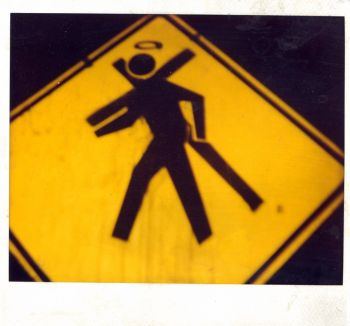 Say amen, somebody.
Say amen, somebody.
There’s also, from Playing for Change, the musical version.

Family resemblence, the art version
Victoria Haven, subject of the previous post, is a member of a large family – artists interested in grids inspired and/or undermined by the organic, the decorative, the home crafts (like quilts) and the musical. If I could play the piano, I’d use Haven’s work as sheet music.
A group show on this theme would be nice. Here’s a start on whom I’d put in it, besides, of course, Haven. Click images to enlarge.
(Left to right)
First row: Chauney Peck, Emily Pothast, Harold Hollingsworth and Jen Liu
Second row: Martin Puryear, Peter Millett, Eric Eley and Noah Grussgott



